An iconic masterpiece in the history of Bologna and Ercole de' Roberti: the Portrait of Giovanni II Bentivoglio
One of the most recent achievements of the Bologna of art lies in having brought back a masterpiece by Ercole de’ Roberti (Ferrara, c. 1450 - 1496), the Portrait of Giovanni II Bentivoglio, to the Museum of Palazzo Poggi, the ancient aristocratic residence erected in the mid-sixteenth century, then in 1711 purchased by the Bolognese Senate to install there the Institute of Sciences and Arts, then still since 1803 the seat of the University of Bologna: today, still a university seat, the building houses the museum that houses the university’s historical collections of anatomy, obstetrics, physics, chemistry, natural history, military architecture, geography and nautics (the Palazzo Poggi Museum, precisely), the European Student Museum, and the Specola Museum. Here, in Palazzo Poggi, hidden in an attic, the portrait was found, thanks to art historian Igino Benvenuto Supino (Pisa, 1858 - Bologna, 1940), who found it in a disastrous state of preservation, forgotten by all. Nothing is known about the painting’s previous history or how it got here, but about its state and why it was hidden one may perhaps have some idea, about which more will be said in a moment.
As mentioned, Supino is credited with rediscovering this great masterpiece, one of the greatest expressions of portraiture produced within the 15th-century Ferrarese school. However, it was another great scholar, Roberto Longhi, who published it and was the first to provide a critical framing of the painting. Longhi, before anyone else, spoke of this work, devoting an extensive passage to it in his 1940 Ampliamenti all’Officina Ferrarese, which will be worth quoting also for the brief yet imaginative description he gave of it: “but there is more to be added to Ercole’s Bolognese period: and that is the portrait of Giovanni II Bentivoglio, which belongs to the University of Bologna and can be seen exhibited in the Institute of Art History. Excavated many years ago, by Supino, from the attics of the Studio Bolognese, I found it in 1934 horribly soiled and scorched to the point that it was barely drawn from the Bentivoglio’s ”breakdown“ in 1507. I devotedly arranged to have, ”meis impensis“ and before my eyes, the soiling removed; to restore the painting to the original format that had been reduced by a badly overmoulded frame; to have the most serious gaps filled in with simple patches of dotted paint, and today I can present it again, more frankly, in its ruined state, but of what prestige, still! Half-figured a little less large than true, but towering by the enormous filling of the torso beneath the emerald-green zymara of brown and gold reverses and soppanni; and thus raised still and set back his head to look invincibly down upon us from above, with tremendous supercilium, rolling the pupil in the corner of the orbit; here is the most exalted type of the Italian ”high-brow“ of the fifteenth century. Such a result can be recalled only by comparison with the Louvre’s Condottiero or Antonello’s Trivulzio portrait; not least because, similarly, the inner firmness does not ask the material embodying it to stiffen and simulate incorruptibility; on the contrary, it takes advantage of certain modeling fuzziness; of delicacy, even, in the very clear mane that opens on the sides of the face in the guise of a light curtain, over which a finger, trying it on, would glide as over the tender, molten manes of the bow of a violin.”
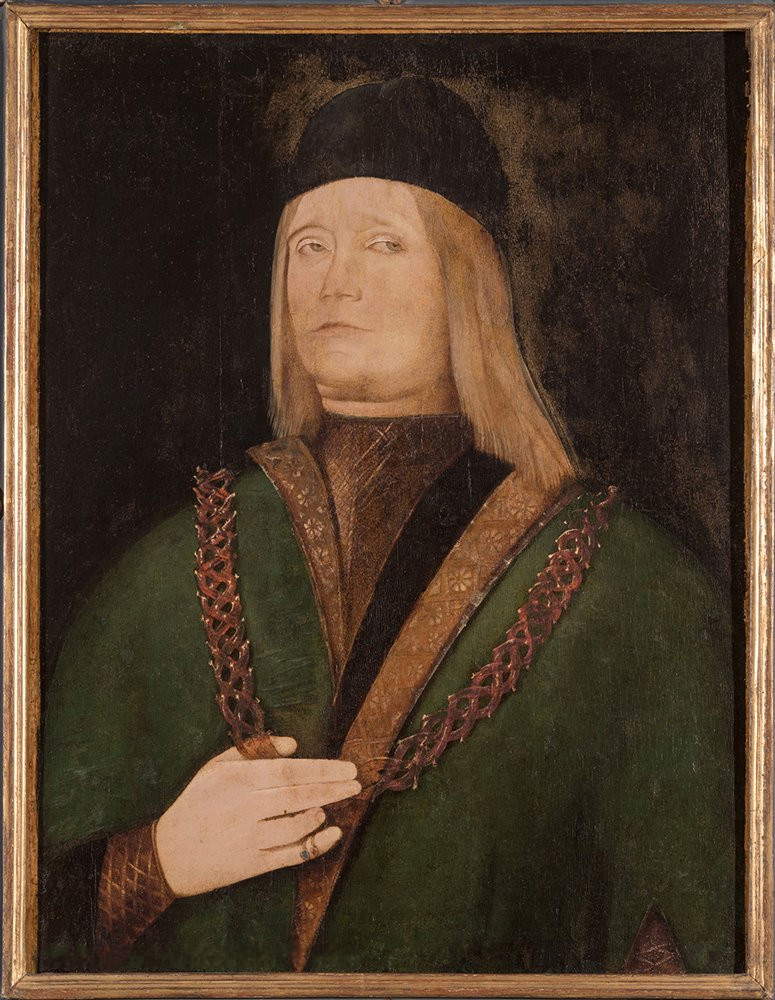 |
| Ercole de’ Roberti, Portrait of Giovanni II Bentivoglio (c. 1485; panel, 64 x 49.5 cm; Bologna, Museo di Palazzo Poggi). Ph. Antonio Cesari © University of Bologna |
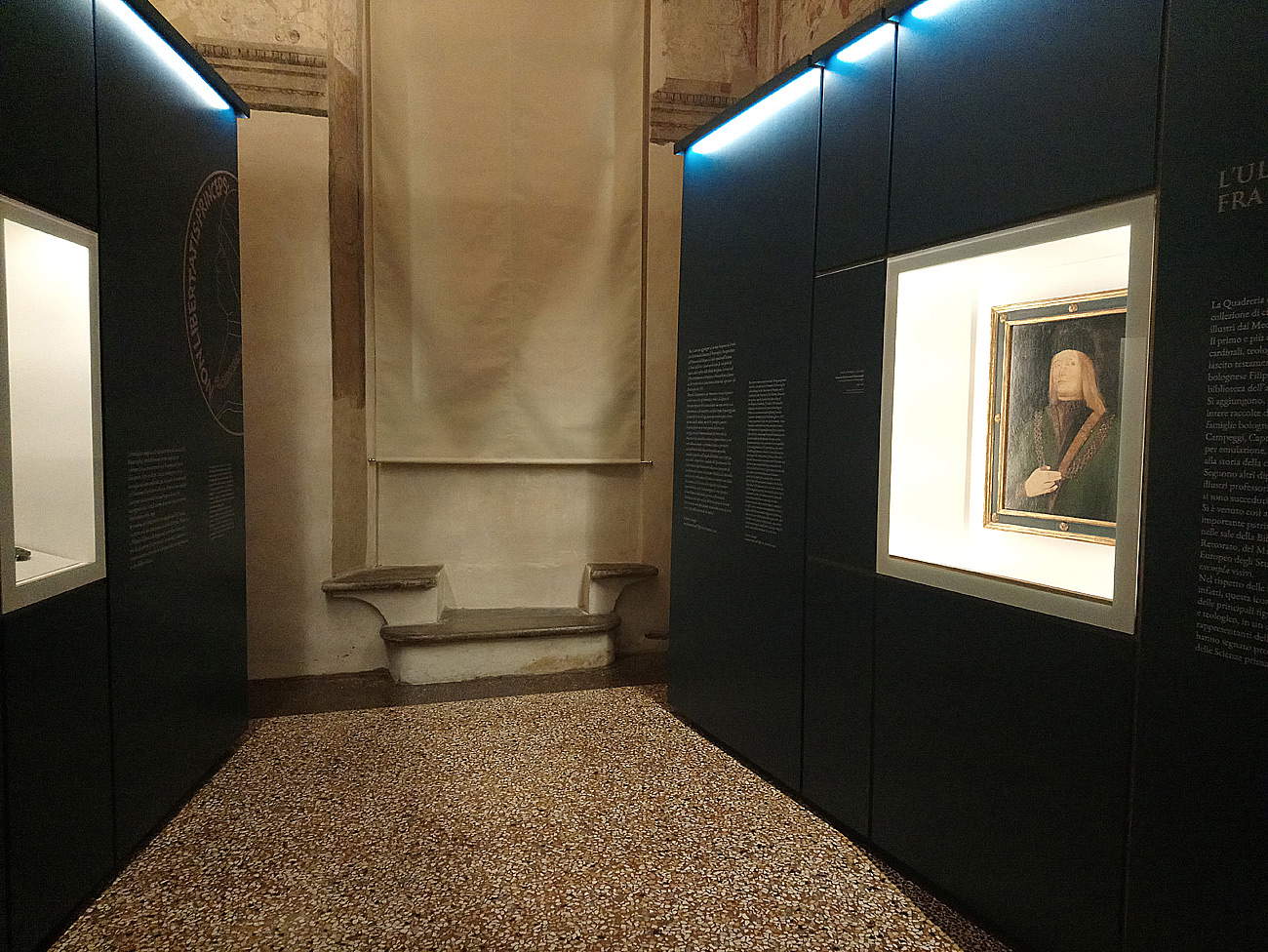 |
| The portrait of Giovanni II Bentivoglio in its new display at the Museo di Palazzo Poggi. Ph. Credit Finestre Sull’Arte |
To learn about the events behind the Bentivoglio “failure” of 1507, it is worth summarizing the story of the character depicted by Ercole de’ Roberti, Giovanni II Bentivoglio (Bologna, 1443 - Milan, 1508), who inherited the lordship of Bologna when he was only two years old, after his father Hannibal was assassinated as part of a conspiracy, later failed, to overthrow Bentivoglio’s rule, hatched by rival families. Rising to power at the age of 20 following the demise of his guardian (as well as regent of the seignory), Sante Bentivoglio, Giovanni II established an intelligent policy that, on the foreign plane, was aimed at strengthening relations with Bologna’s allies (the Sforzas, the Medicis, and the Republic of Venice), while in domestic politics the young lord took steps to strengthen his personal power: for example, measures to limit the power of the papal legate (Bologna, in fact, was formally dependent on the Papal States), reforms of city institutions to ensure his control over them, and appointments of people close to him to the most important roles in the city’s administration. John II’s lordship soon took on the connotations of a tyranny that did not allow interference, but it should also be emphasized that Bentivoglio, for many years, enjoyed the support of the people, which he procured through extensive patronage (the Renaissance spread in Bologna thanks to John II’s action) and above all through policies favorable to the most disadvantaged classes (for example, with measures aimed at averting the risk of rising prices of basic goods during famines).
John II’s power began to weaken from 1488, the year in which two episodes negatively marked his rule. The first was his imprisonment for a few days in Faenza: in 1488 his daughter Francesca, married to Galeotto Manfredi, lord of the Romagnola city, had the latter killed by two hired assassins (in fact, it was a failed marriage, since Manfredi did not want to separate from his mistress, and he never had a good relationship with his wife), forcing John II to intervene since Faenza was without its ruler. John II appointed Galeotto and Francesca’s son Astorre Manfredi, a three-year-old boy, as lord of Faenza: however, the people of Faenza considered the episode a heavy interference, rose up against Bentivoglio and imprisoned him. The incident took on the contours of international scandal, and only the intervention of Lorenzo the Magnificent, an ally of John II, after some negotiations with the Faentines, averted the risk of a military response from the Bolognese. The second was the conspiracy of the Malvezzi, a rival family of the Bentivoglio, who had resented the transformation of Bologna into the personal dominion of John II, as well as the inexorable loss of prestige that the centralization of power in the hands of the lord had brought to their detriment: having discovered the Malvezzi plots, the Bentivoglio and their partisans gave rise to a ferocious repression made up of numerous executions preceded by summary trials and ruthless killings of people on whom even mere suspicions hung.
From this point on, the lord’s tyrannical policy became increasingly exposed (for example, with the assignment of the office of gonfaloniere for life to his 23-year-old son Hannibal II: a move through which John II guaranteed officiality to the hereditary transmission of the seigniory, since until then the Bentivoglios had only been de facto lords of Bologna), and discontent continued to grow with the change of attitude in foreign policy after the descent of Charles VIII, king of France, to Italy. John II was well aware that he had numerous adversaries in the city, and especially that his power was based on benevolence on the part of the people: consequently, in order to avoid bringing war to Bolognese territory (which would have alienated him from the favor of the population, causing the collapse of the seigniory), he maintained ambiguous behavior toward foreign powers, which had the effect of saving Bologna from war and keeping power firmly in his hands, but represented the first chapter in a series of ambivalent actions that soon led to his downfall. When, a short time later, Louis XII of France began the conquest of the Duchy of Milan, John II first helped his Sforza ally, and then, seeing that the war was turning in favor of the French, Bentivoglio abandoned the Sforzas in order to obtain Louis XII’s protection, granted, however, in exchange for a heavy economic tribute, the payment of which was judged internally as a sign of weakness. Not only that: in 1501, Bologna was in fact threatened by the belligerent Cesare Borgia, son of Pope Alexander VI and violent arm of the aggressive territorial expansion policy of the Papal States that was aiming straight at the city of Bologna. John II hosted in Bologna the lords of some of the cities conquered by Borgia, and the latter, in retaliation, attacked and conquered Faenza (the very young Astorre Manfredi, then 17 years old, was taken prisoner to Rome and murdered shortly afterwards): the Bolognese lord resolved the situation again by diplomacy, reaching peace with the threat of an armed revolt by the city against the papal army and the payment of a further economic tribute. However, papal aims were dormant for only a few years.
Struck by further internal crises (starting with the conspiracy of the Marescotti, another rival family, which was suppressed with a repression that was even more violent than that which fell on the Malvezzi: the indiscriminate massacres that occurred alienated John II much of the favor of the citizens) and from a very heavy economic situation that weakened Bologna financially, grew the opposition of the survivors of the Malvezzi and Marescotti families who, in Rome, were pressuring Pope Julius II for a new military intervention against Bologna, and lost some strategic international alliances (the French had in fact come dangerously close to the Papal States, to the entire detriment of the Bolognese seigniory), John II saw his own power inevitably compromised. In 1506 Julius II, realizing that Bologna was crucial to the territorial expansion of the Holy See and assessing his lord’s position as no longer strong, attacked the city, and this time John II’s diplomatic skill was to no avail, since France and Venice had no interest in taking sides against the pontiff. The pope’s action was violent: he placed a bounty on the head of John II, who was considered a rebel, and threatened anyone in the city who helped him with excommunication. The lord, having also lost the support of the people (who did not move against the Bentivoglios, but neither did they help them in the face of the papal threat), and realizing the imminent end of his rule, worked for an agreement with the pope to renounce Bologna and move out of the territories of the Papal States: in return, John II would obtain the survival of his family and the salvation of his property. The now former lord of Bologna agreed with his old ally, Louis XII, to go into exile in Milan. The following year, 1507, with the Bentivoglios now out of the city, their rivals, led by the Marescotti, stirred up the mob in an attempt at damnatio memoriae: the most important Bentivoglio vestige left in the city was their sumptuous palace, which was attacked by the people and torn down. All that was left of the building, which stood on the site where the Teatro Comunale in Piazza Verdi stands today, was rubble, and the event went down in the historical record as the "Bentivoglio breakdown." Evidence of the devastation still survives in toponymy: in Bologna there is a Via del Guasto, which connects today’s Via delle Belle Arti and Via Zamboni at the site of Palazzo Bentivoglio, and the Giardino del Guasto, which is located where the palace’s garden once stood.
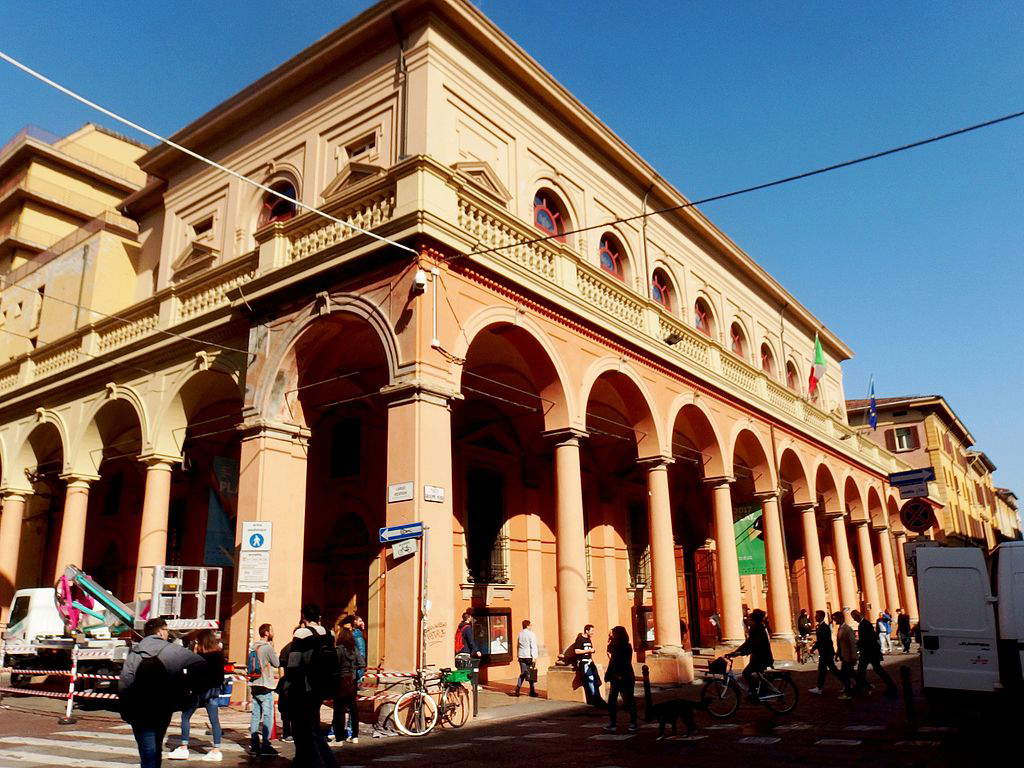 |
| The Municipal Theater of Bologna, built on the site where Palazzo Bentivoglio once stood. Ph. Credit |
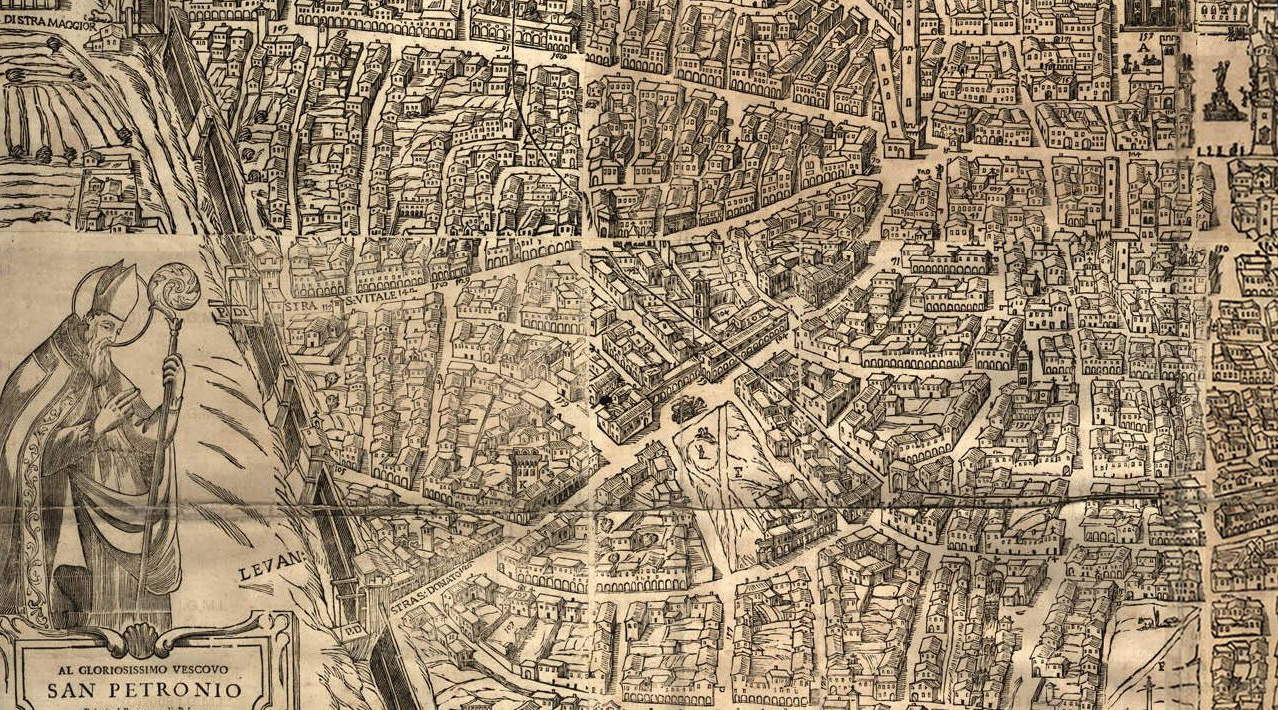 |
| The map of Bologna made in 1638 by Matteo Borboni (and later updated in 1724) with, at lower left, still the rubble at the site of the Bentivoglio’s failure, between today’s Via Zamboni and Via delle Belle Arti |
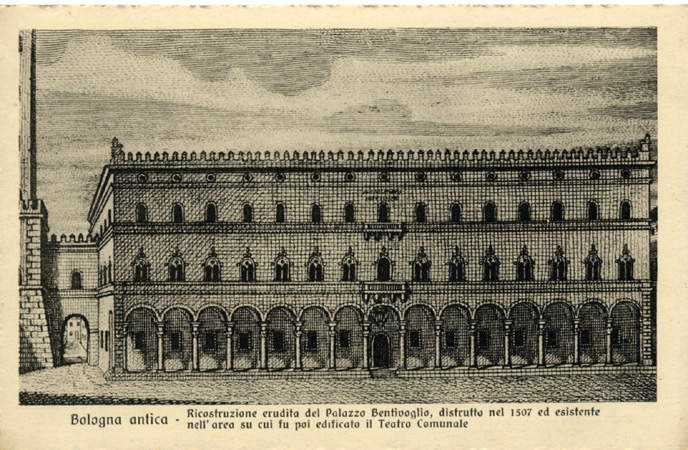 |
| Ideal reconstruction of Palazzo Bentivoglio in a 19th-century engraving |
Longhi therefore believed that the portrait executed by Ercole de’ Roberti was a work that somehow escaped the fault: the painting was probably hidden somewhere in the city, and then nothing more was known about it until the date of its discovery. As a result, no documentary evidence of the portrait has even survived. Or rather: the work might be attested in the ancient inventories of the University of Bologna, but since cataloguers of the eighteenth century or later certainly did not recognize the personage, it is impossible to determine whether or not the painting is on any list. The attribution to Ercole de’ Roberti was in fact formulated by Longhi on the basis of stylistic evidence. In addition, the Piedmontese scholar identified the person depicted in Giovanni II Bentivoglio on the basis of comparison with other images that are preserved of the lord: we have, for example, another portrait of Ercole de’ Roberti that depicts him (it is one of the two panels of the famous Bentivoglio Diptych of about 1475, where the lord, then in his early thirties, is portrayed in profile, paired with his wife Ginevra Sforza: currently the two precious portraits are in the National Gallery in Washington), or the portrait executed around 1490 by Lorenzo Costa (Ferrara, 1460 - Mantua, 1535), now in the Uffizi, or even the image of the lord of Bologna that appears in the famous Bentivoglio Altarpiece of 1488, in the church of San Giacomo Maggiore in the Emilia capital (John II is kneeling at the feet of the Madonna). But there are more than just the painted images: at the Museum of Palazzo Poggi, right in front of the portrait, the public can view the Medal for John II Bentivoglio, granted to the university museum on deposit from the Civic Archaeological Museum of Bologna. It is a bronze medal, executed in 1462 by one of the most important medallists of the time, Sperandio Savelli (Mantua, c. 1425 - Venice, 1504), who drew the then 19-year-old Giovanni on the obverse of the medal (while on the reverse we can observe the Bentivoglio coat of arms). It was probably an object made to celebrate Giovanni’s proclamation as Princeps of the Senate of Bologna, i.e., head of the Senate, as the inscription running on the edge would attest (“Ioanes Bentivolus Bonon. libertatis princeps,” or “Giovanni Bentivoglio bolognese prince of liberty”: “Libertas” being the motto of the city of Bologna).
Longhi also put forward the hypothesis that it must be a work from the 1480s (also because Ercole de’ Roberti left Bologna for good in 1486), given the appearance of the gentleman and given the style close to that of the works that the Ferrara artist executed in that period. In particular, a strong resemblance has been noted to the frescoes of the destroyed Garganelli Chapel, which was located in St. Peter’s Cathedral in Bologna and was later demolished in the 17th century as part of the reconstruction work on the sacred building: today, the only surviving fragment is the Weeping Magdalene found in 1943 and kept at the Pinacoteca Nazionale in Bologna, while other pieces of the ancient decoration are known through copies. In particular, scholars Andrea Bacchi and Daniele Benati have pointed out, “the Garganelli frescoes and the Portrait of Palazzo Poggi appear to be united by a very individual openness to the ’modern manner,’” and the closest comparison is precisely with the Weeping Magdalene, "which binds very well in its palpitating incisiveness to the better-preserved pieces of the Portrait.“ Indeed, all scholars could not help but emphasize the vividness of the portrait, which lets the pride and pride of Giovanni II Bentivoglio seep through: as we have seen, it is not by chance that Longhi compared it, by virtue of its ”inner firmness," to two coeval masterpieces by Antonello da Mess ina (Messina, 1430 - 1479), the Ritratto d’uomo also known as Il condottiero, now in the Louvre, and the Ritratto Trivulzio kept instead in Turin, at Palazzo Madama. All are portraits whose subjects, with their stern frowns, display confidence almost to the limit of pride.
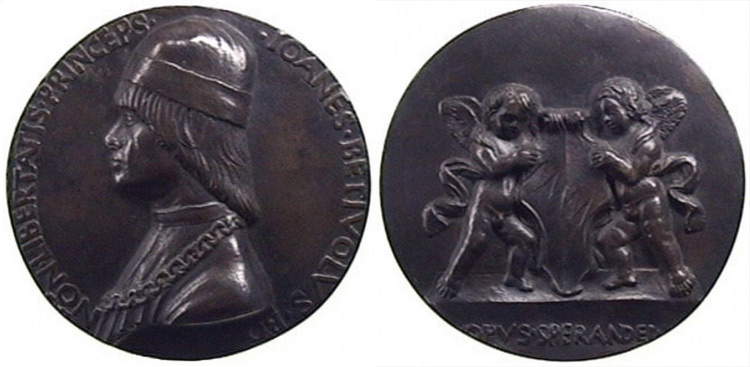 |
| Sperandio Savelli, Medal of Giovanni II Bentivoglio (c. 1462; bronze, diameter 110 mm; Bologna, Museo di Palazzo Poggi, on deposit from Museo Civico Archeologico) |
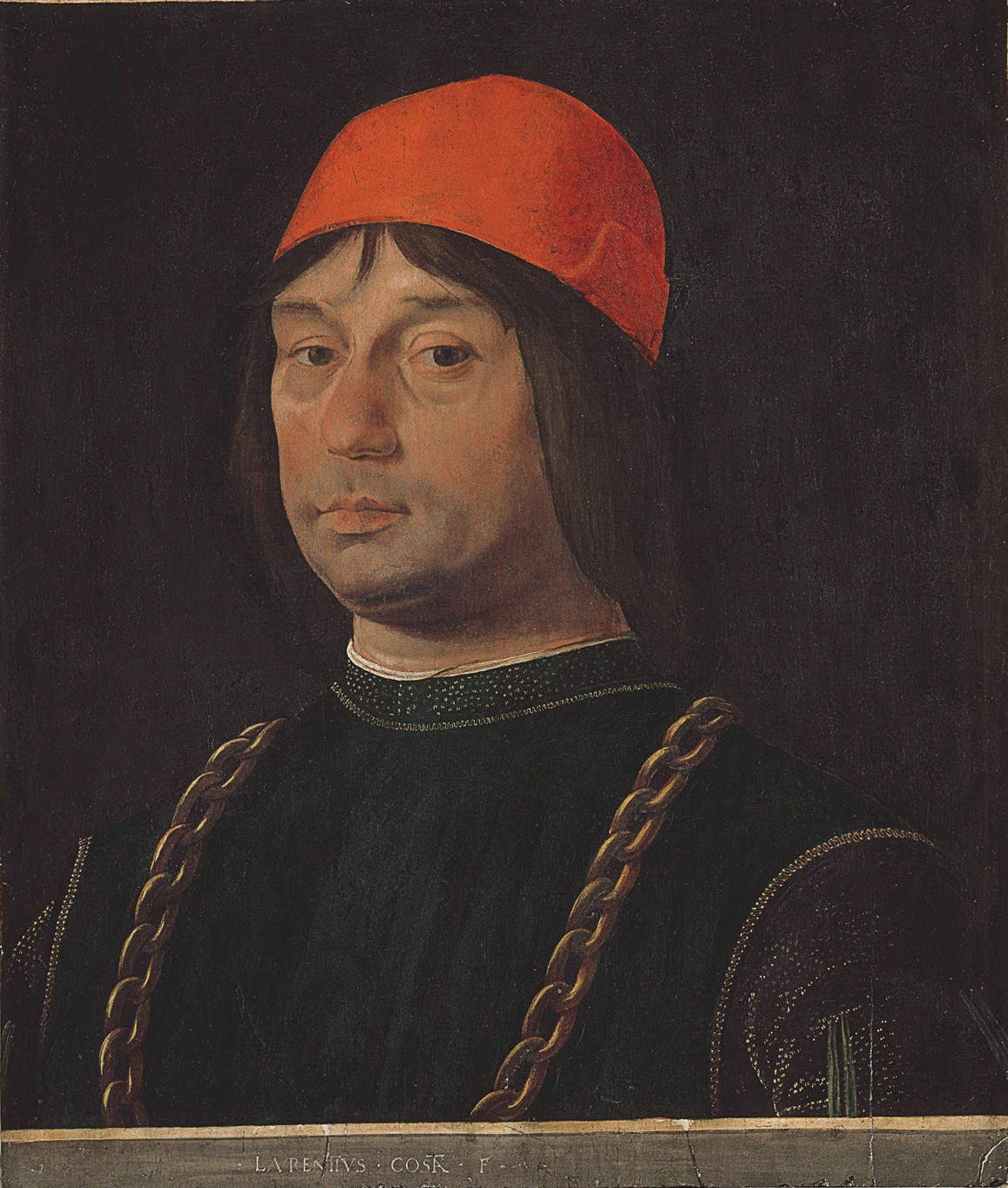 |
| Lorenzo Costa, Portrait of Giovanni II Bent ivoglio (c. 1490; tempera on panel, 55 x 47 cm; Florence, Uffizi Gallery) |
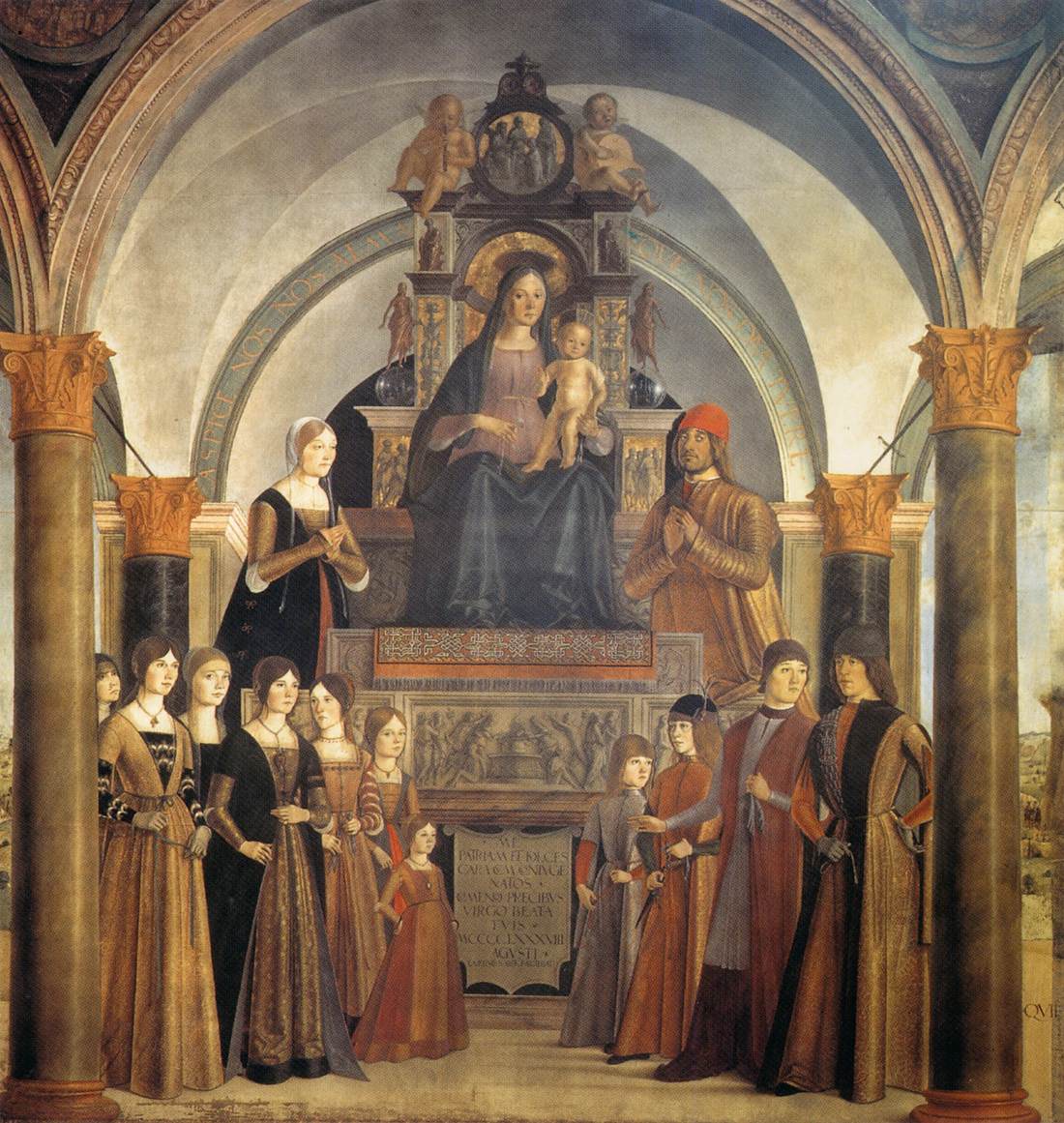 |
| Lorenzo Costa, Bentivoglio Altarpiece (1488; tempera on panel; Bologna, San Giacomo Maggiore) |
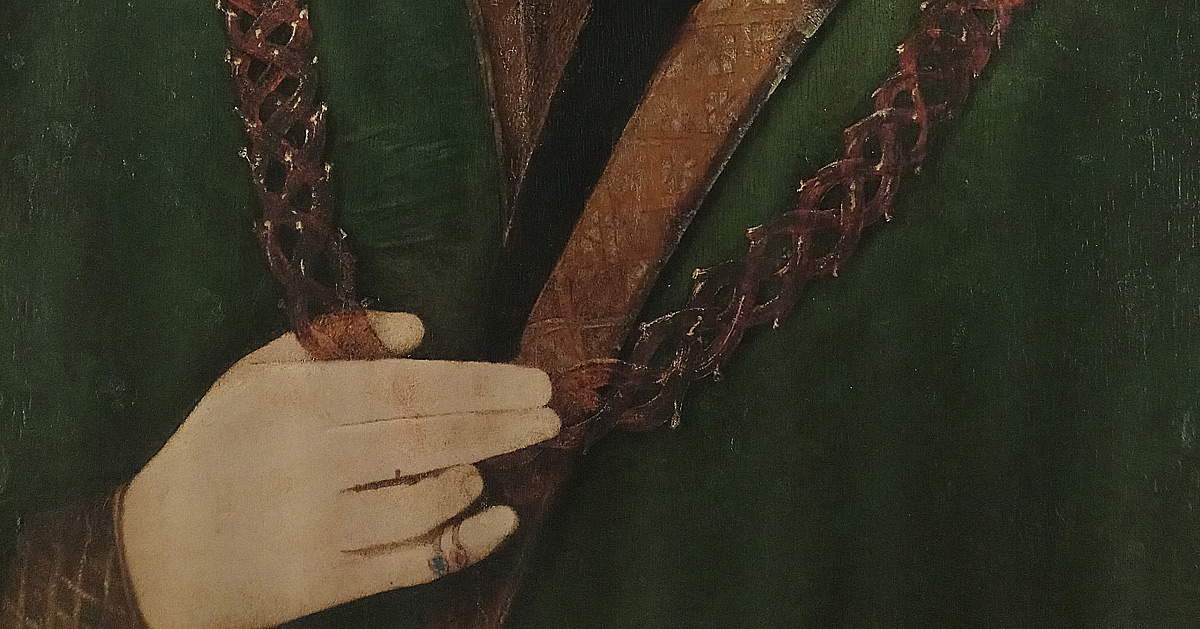 |
| Ercole de’ Roberti, Portrait of Giovanni II Bentivoglio, detail |
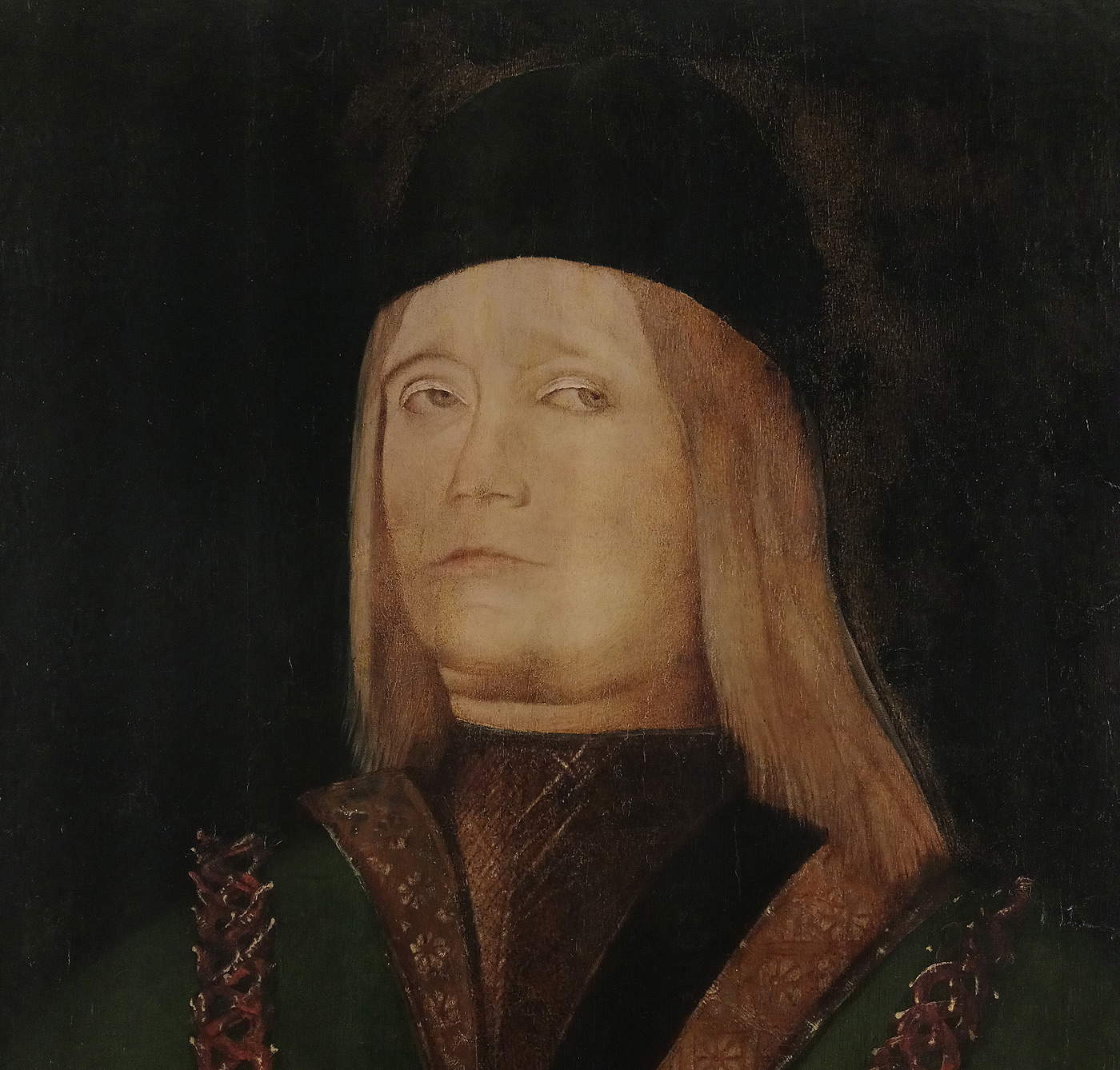 |
| Ercole de’ Roberti, Portrait of Giovanni II Bentivoglio, detail |
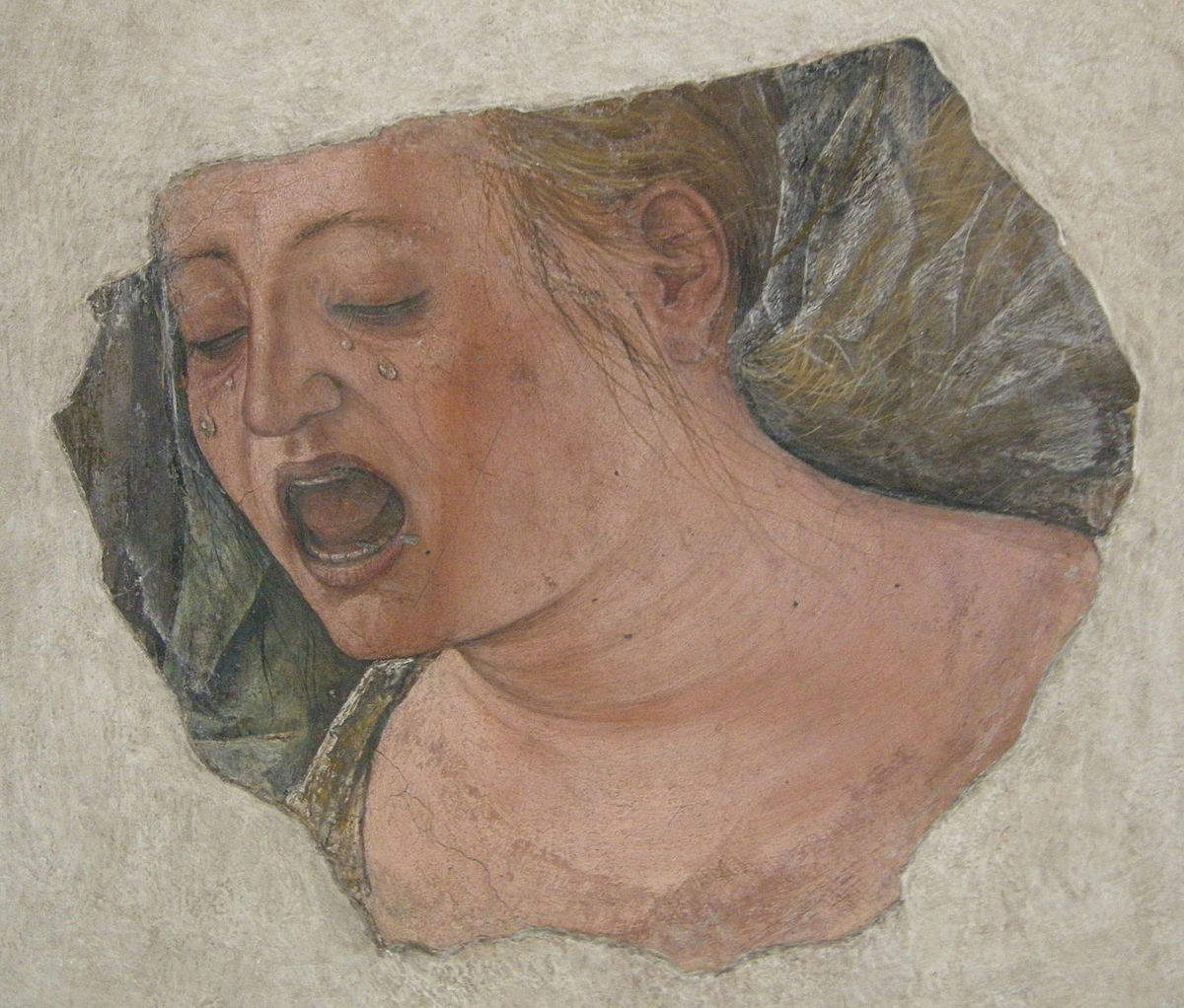 |
| Ercole de’ Roberti, Weeping Magdalene’s Face (1478-1486; fresco, 24.5 x 28.5 cm; Bologna, Pinacoteca Nazionale) |
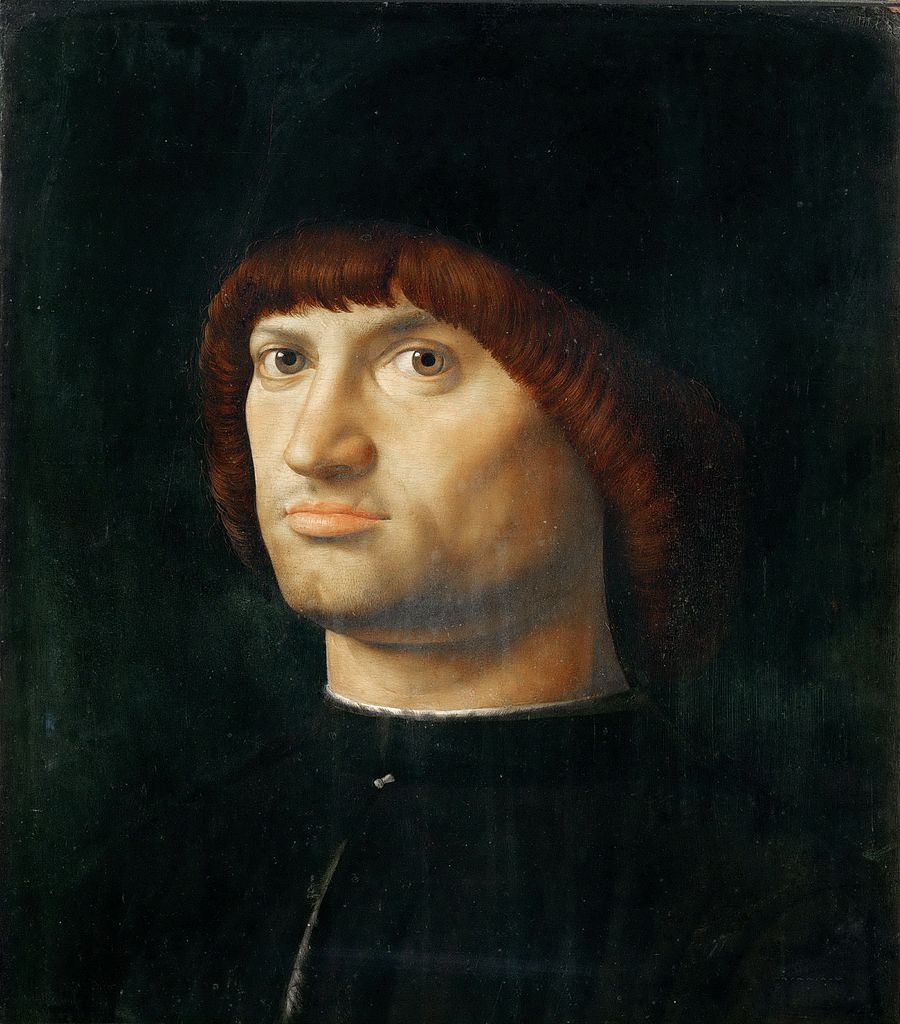 |
| Antonello da Messina, Portrait of a Man Known as Il condottiero (c. 1475; oil on panel, 36 x 30 cm; Paris, Louvre) |
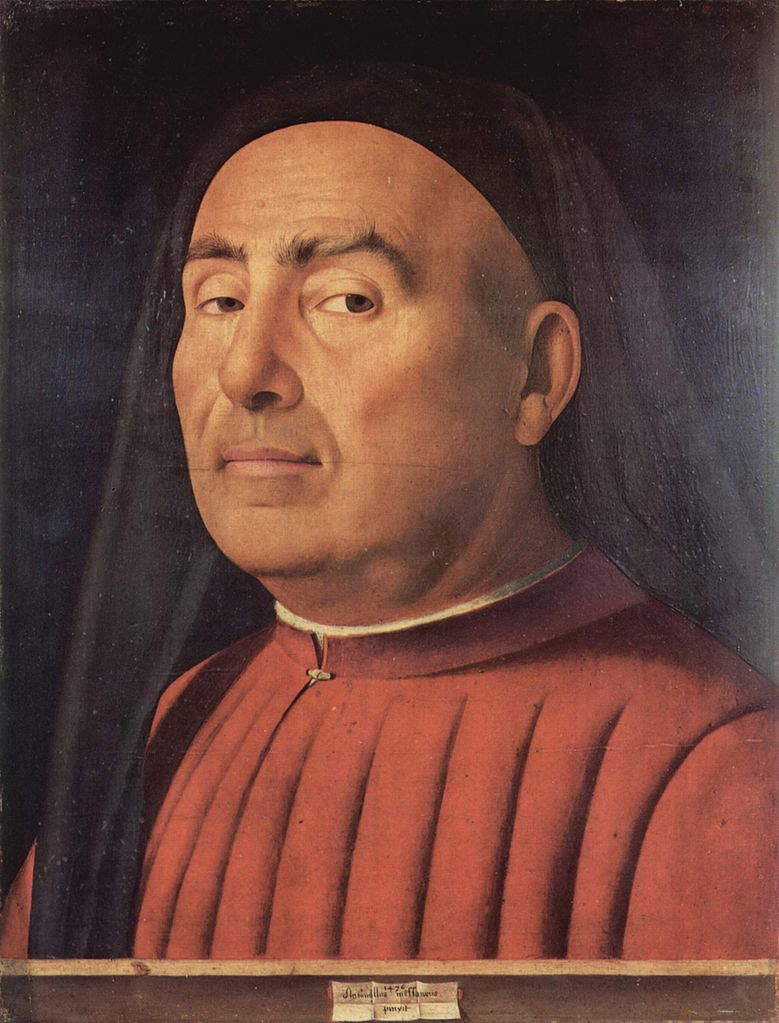 |
| Antonello da Messina, Portrait of a Man known as Ritratto Trivulzio (1476; oil on panel, 37.4 x 29.5 cm; Turin, Museo Civico d’Arte Antica) |
Mention was made just above of the Bentivoglio Diptych, another masterpiece by Ercole de’ Roberti, for which the comparison with the Portrait of John II seems almost natural, so much so that it is also proposed in the essay by Bacchi and Benati in which the Palazzo Poggi work is examined. The Diptych, a work in which John II, as anticipated, is depicted in profile paired with his wife according to the formula that Piero della Francesca (Borgo Sansepolcro, c. 1412 - 1492) had adopted in his very famous Diptych of the Dukes of Montefeltro (and which was certainly well known in Bologna since Ginevra Sforza was sister of Battista Sforza, wife of Federico di Montefeltro, and therefore the Urbino and Giovanni II were brothers-in-law), is the oldest known portrait of Ercole de’ Roberti: however, if the latter was part of a well-established tradition (since, as is well known, the profile portrait, due to its echoing the numismatics of ancient Rome, was the favorite format of Renaissance lords) and qualified “as a sort of ideal concluding moment of the great season of the ’humanistic portrait,’ which precisely in Emilia, in the Ferrara of Lionello d’Este, had had one of its most vital chapters of initiation” (Bacchi and Benati); on the contrary, the Portrait of John II responds to much more modern impulses, which, moreover, had already become apparent in Bologna itself. Clear proof of this is the Portrait of a Man with Ring painted by another Ferrara-born artist, Francesco del Cossa (Ferrara, c. 1435-Bologna, 1476/1477), who chose a frontal setting for his subject, combining it with a perspective foreshortening with a strongly illusionistic flavor (note the detail of the hand reaching out toward the relative, beyond the marble balustrade), for a result that suggests the author’s knowledge of Flemish works. Moreover, when the work was “rediscovered,” Berenson ascribed it to Ercole de’ Roberti, while we still owe to Longhi the attribution to the hand of Francesco del Cossa and in particular to the time of his Bolognese period: an intuition that would later be confirmed by other scholars.
Concluding the reading of the Palazzo Poggi painting, one might assume that the powerful portrait was executed in the 1580s not only for stylistic reasons that link it to other works of the period, but also by virtue of political reasons: the 1580s in fact represented the height of Bentivolese power, which is why in that period John II was almost committed, Bacchi and Benati explain, “to eloquently translating his increased political stability into images.” Perhaps, also for this reason, the portrait of the 1980s marks a change of pace also stylistically, with a monumental rendering that not only enhances the severity of the mature John II (it is a portrait that, compared to the image of the Bentivoglio Diptych, elicits quite a different impression), but could also be configured as a declaration of his political authority. A painting, in short, extremely up-to-date designed to be highly communicative. In other words, with this extraordinary painting Ercole de’ Roberti placed himself in the wake of the artists who had paved the way for modern portraiture.
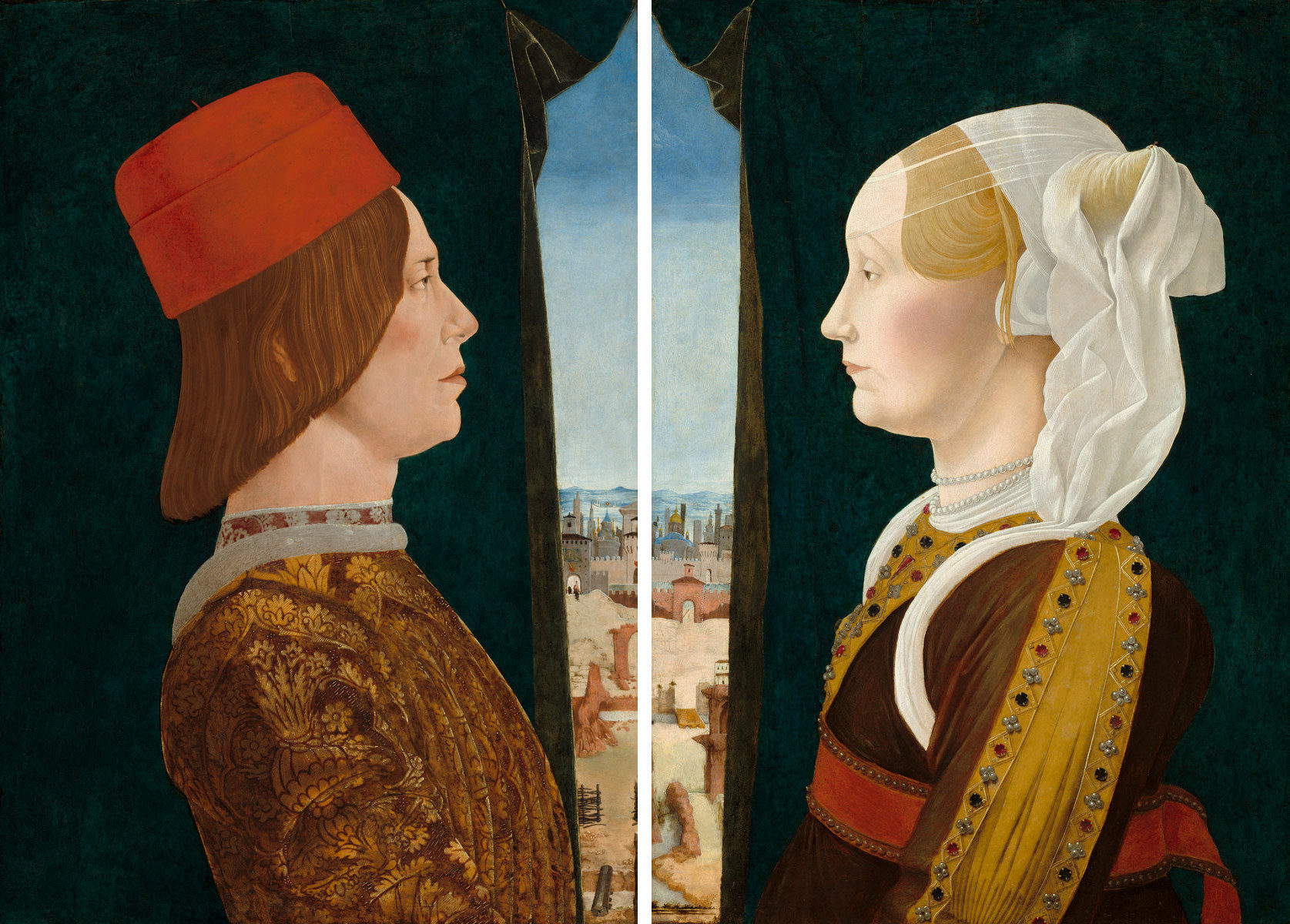 |
| Ercole de’ Roberti, Portrait of Giovanni II Bentivoglio and Portrait of Ginevra Sforza, known as Bentivoglio Diptych (both c. 1475; tempera on panel, 54 x 38 cm; Washington, National Gallery of Art) |
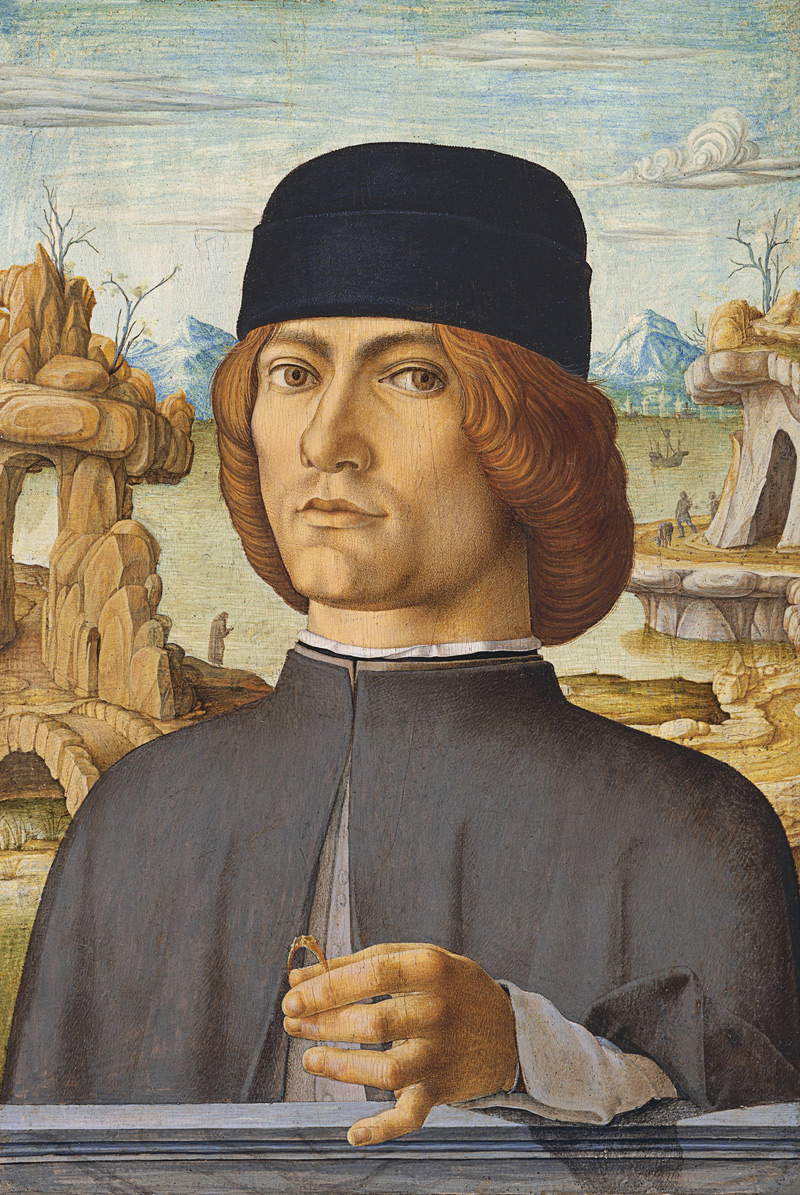 |
| Francesco del Cossa, Portrait of a Man with Ring (c. 1472-1477; tempera on panel, 38.5 x 27.5 cm; Madrid, Museo Nacional Thyssen-Bornemisza) |
Longhi, as mentioned at the outset, examined it that it was in a severely deteriorated state and had it fixed at his own expense (and a further restoration was conducted in 2003), although, by then, the work was compromised: too abraded was the pictorial film to attempt to have a full appreciation of how it should have originally appeared, with the result that the image of the gentleman is irreparably flattened. Yet even in that state, the painting is able to happily evoke the genius of Ercole de’ Roberti, the power of his expressive language, and the lord’s proud character. The painting, which had been on display for some time at the Museum of the History of Bologna in Palazzo Pepoli, returned in June 2018 to Palazzo Poggi, in a new setting specially created by architect Cesare Mari and the firm Tosetto, which specializes precisely in interior settings. For the portrait, as emphatically emphasized at the time of relocation, it was a double homecoming: to the place where it was found, and to the neighborhood where Giovanni II Bentivoglio lived.
Reference bibliography
- Vera Fortunati Pietrantonio, A Lord in the Mirror. The portrait and palace of Giovanni II Bentivoglio, Editrice Compositori, 2003
- Monica Molteni, Lionello Puppi (eds.), Ercole de’ Roberti. Historical catalog, Silvana Editoriale, 1995
- Alessandra Mottola Molfino, Mauro Natale (eds.), Le muse e il principe: arte di corte nel Rinascimento padano, exhibition catalog (Milan, Museo Poldi Pezzoli, from September 20 to December 1, 1991), Panini Editore, 1991
- Andrea Bacchi, Daniele Benati, The collection of paintings through five files, in Anna Ottani Cavina (ed.), Palazzo Poggi. From aristocratic residence to seat of the University of Bologna, Nuova Alfa, 1988, pp. 138-147.
- Roberto Longhi, Ampliamenti nell’Officina Ferrarese, Sansoni, 1940.
Warning: the translation into English of the original Italian article was created using automatic tools. We undertake to review all articles, but we do not guarantee the total absence of inaccuracies in the translation due to the program. You can find the original by clicking on the ITA button. If you find any mistake,please contact us.




























